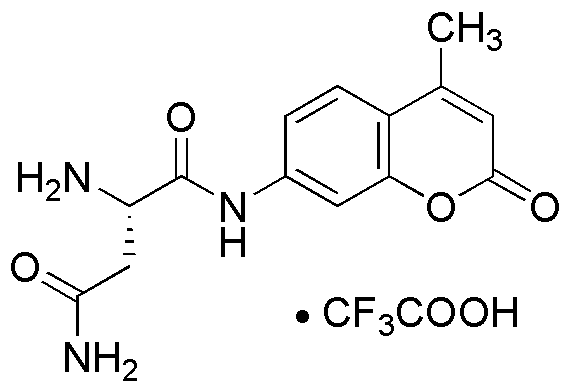L-Asparagine 7-amido-4-methylcoumarin trifluoroacetate is widely utilized in research focused on:
- Fluorescent Probes: This compound is used as a fluorescent probe in biochemical assays, allowing researchers to visualize and track cellular processes with high sensitivity.
- Enzyme Activity Studies: It serves as a substrate in enzyme activity assays, helping scientists understand enzyme kinetics and mechanisms, particularly in metabolic pathways.
- Drug Development: The compound plays a role in the development of new pharmaceuticals, especially those targeting specific biochemical pathways, enhancing drug efficacy and specificity.
- Biomolecular Research: It is employed in studies of protein interactions and folding, providing insights into protein structure and function that are crucial for biotechnology applications.
- Diagnostics: This chemical is also explored in diagnostic applications, where its properties can aid in the detection of certain diseases through biomarker identification.
General Information
Properties
Safety and Regulations
Applications
L-Asparagine 7-amido-4-methylcoumarin trifluoroacetate is widely utilized in research focused on:
- Fluorescent Probes: This compound is used as a fluorescent probe in biochemical assays, allowing researchers to visualize and track cellular processes with high sensitivity.
- Enzyme Activity Studies: It serves as a substrate in enzyme activity assays, helping scientists understand enzyme kinetics and mechanisms, particularly in metabolic pathways.
- Drug Development: The compound plays a role in the development of new pharmaceuticals, especially those targeting specific biochemical pathways, enhancing drug efficacy and specificity.
- Biomolecular Research: It is employed in studies of protein interactions and folding, providing insights into protein structure and function that are crucial for biotechnology applications.
- Diagnostics: This chemical is also explored in diagnostic applications, where its properties can aid in the detection of certain diseases through biomarker identification.
Documents
Safety Data Sheets (SDS)
The SDS provides comprehensive safety information on handling, storage, and disposal of the product.
Product Specification (PS)
The PS provides a comprehensive breakdown of the product’s properties, including chemical composition, physical state, purity, and storage requirements. It also details acceptable quality ranges and the product's intended applications.
Certificates of Analysis (COA)
Search for Certificates of Analysis (COA) by entering the products Lot Number. Lot and Batch Numbers can be found on a product’s label following the words ‘Lot’ or ‘Batch’.
Número de catálogo
Número de lote/lote
Certificates Of Origin (COO)
This COO confirms the country where the product was manufactured, and also details the materials and components used in it and whether it is derived from natural, synthetic, or other specific sources. This certificate may be required for customs, trade, and regulatory compliance.
Número de catálogo
Número de lote/lote
Safety Data Sheets (SDS)
The SDS provides comprehensive safety information on handling, storage, and disposal of the product.
DownloadProduct Specification (PS)
The PS provides a comprehensive breakdown of the product’s properties, including chemical composition, physical state, purity, and storage requirements. It also details acceptable quality ranges and the product's intended applications.
DownloadCertificates of Analysis (COA)
Search for Certificates of Analysis (COA) by entering the products Lot Number. Lot and Batch Numbers can be found on a product’s label following the words ‘Lot’ or ‘Batch’.
Número de catálogo
Número de lote/lote
Certificates Of Origin (COO)
This COO confirms the country where the product was manufactured, and also details the materials and components used in it and whether it is derived from natural, synthetic, or other specific sources. This certificate may be required for customs, trade, and regulatory compliance.


